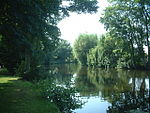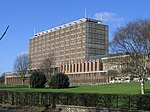Trowse
AC with 0 elementsCivil parishes in NorfolkModel villagesSouth NorfolkUse British English from April 2022 ... and 1 more
Villages in Norfolk

Trowse (pronounced by those from Norwich and by elderly residents of the village), also called Trowse with Newton, is a village in South Norfolk which lies about 1+1⁄2 miles (2.4 km) south-east of Norwich city centre on the banks of the River Yare. It covers an area of 4.49 km2 (1.73 sq mi) and had a population of 479 in 233 households at the 2001 census, the population increasing to 862 in 374 households at the 2011 Census. There are approved plans to build a further 770 houses on the outskirts of the village, at White Horse Lane and the Deal Ground sites.
Excerpt from the Wikipedia article Trowse (License: CC BY-SA 3.0, Authors, Images).Trowse
Old Hall Close, South Norfolk Trowse with Newton
Geographical coordinates (GPS) Address Nearby Places Show on map
Geographical coordinates (GPS)
| Latitude | Longitude |
|---|---|
| N 52.612 ° | E 1.32 ° |
Address
Old Hall Close
Old Hall Close
NR14 8SR South Norfolk, Trowse with Newton
England, United Kingdom
Open on Google Maps








